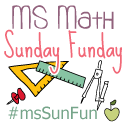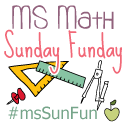5 Tips For Differentiating
Instruction
Choice! We
all enjoy having a choice in our work!
Consider giving students
options for how they practice their math – worksheet, whiteboard, computerized
math, partners, alone. Also look for
options for students to show you that they have mastered content. Can they do the five most difficult
problems? Can they create their own
examples to fit specific parameters?
Could they write a letter or blog post or make a video explaining a
topic?
Make the work brain-friendly!
 Our brains respond well to
music, movement, and color! In any given
lesson consider using 2 or 3 different elements to appeal to students’ various
learning differences. Sing the quadratic
formula, watch a video explaining quadratics, create a chart illustrating three
forms of the quadratic equation, color code notes! Very popular right now are
sketch notes and doodling!
Our brains respond well to
music, movement, and color! In any given
lesson consider using 2 or 3 different elements to appeal to students’ various
learning differences. Sing the quadratic
formula, watch a video explaining quadratics, create a chart illustrating three
forms of the quadratic equation, color code notes! Very popular right now are
sketch notes and doodling!
Vary
how students are grouped in class!
 Most often teachers are encouraged to
create mixed ability groups. While mixed
ability groups have their place, grouping students with the same challenge
needs on occasion allows the teacher to specifically design appropriately
leveled tasks and/or mini-teaching sessions.
Most often teachers are encouraged to
create mixed ability groups. While mixed
ability groups have their place, grouping students with the same challenge
needs on occasion allows the teacher to specifically design appropriately
leveled tasks and/or mini-teaching sessions.
Use
rich problems with multiple entry points!
Rich problems are non-routine in that they are not typical
practice of a skill or algorithm; they have little scaffolding; and students of
varying skill levels can benefit from them. Rich Problems have
natural extensions - one question leads to another. They are difficult and
interesting at the same time. Rich
Problems are revealing! They give insight to teachers about
students' understanding. They help students experience the essence of
mathematics. A few places to find rich problems besides the Twitter math
community include:
Attend to the
learning environment!
 Students may need
opportunities for both quiet work time and collaboration! Students with sensory issues might need less
light, or headphones during independent work time. Alternative seating or vertical work surfaces
can provide differentiation. And last,
create routines so that you can work with small groups while other students
work independently.
Students may need
opportunities for both quiet work time and collaboration! Students with sensory issues might need less
light, or headphones during independent work time. Alternative seating or vertical work surfaces
can provide differentiation. And last,
create routines so that you can work with small groups while other students
work independently.










